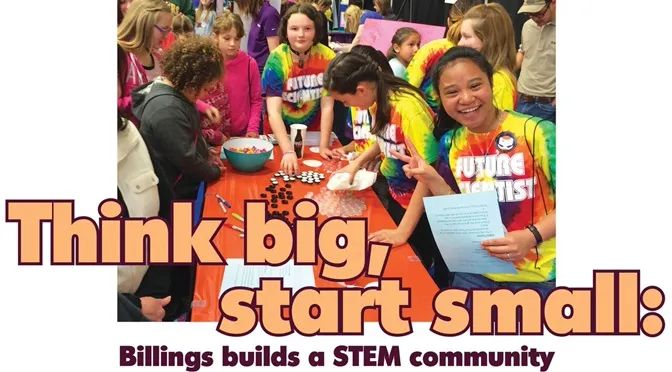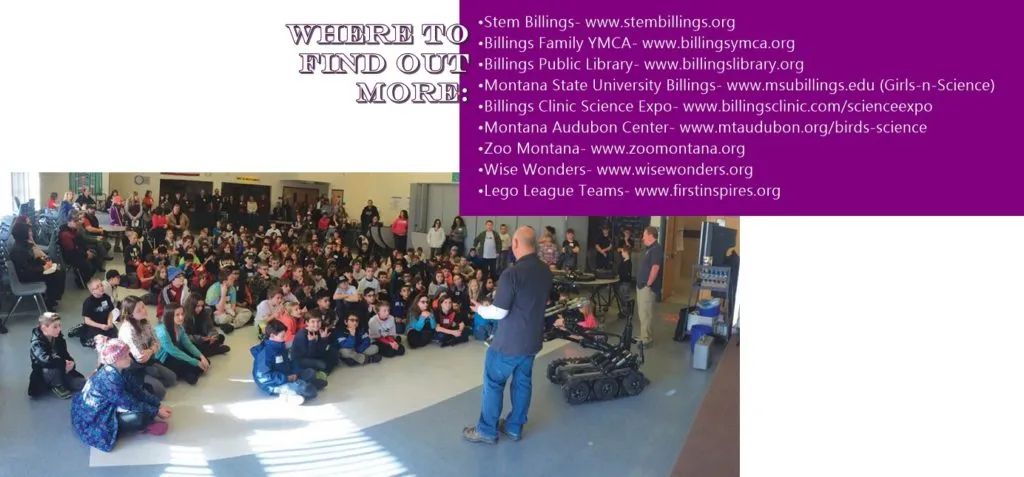
Think big, start small: Billings builds a STEM community
Originally printed in the pages of Simply Family Magazine’s March 2017 issue. Never miss an issue, check out SFM’s digital editions, here!by Dan Carter
Sunshine dances across drifts of snow and ice; it’s a symphony of light and cold, and an opportunity to spark ingenuity.
Outside in various areas around Billings, kids are building snowmen, forts, and jumps on sledding hills. It’s clearly a lot of fun, but upon closer inspection, much more is revealed. Believe it or not, they are starting to grasp some fundamental concepts of science and mathematics – what kind of angle makes the best snow jump, how much energy is used to build it and – when the sun comes out – how much water is in a snowman?
Inside Meadowlark Elementary School, more than 180 kids between grades 3-8 are milling about various experiential stations, soaking up information, and having fun with robotics. They are building hydraulic-operated wooden robotic arms, programming small round Sphero robots with iPads, and figuring out how to turn empty soda pop cans into small robots. They are grasping the fundamental concepts of programming and technological advancements, creatively solving problems, and asking questions about possible solutions.
And while there is clearly a lot of fun the community these days, much is being revealed about the steps Billings has been taking to build a STEM community.
An ecosystem mindset
Whether it is experimenting with snow sculptures, learning about robots, building something from Legos, or looking under rocks for the first sign of spring, children have long demonstrated a clear readiness early in their lives to understand the world around them. These days, all of that is referred to as STEM (science, technology, engineering and mathematics) learning.
Studies have shown – and many parents understand – that brain and skills-building experiences early in life are critical for childhood development. It builds self-confidence, encourages problem-solving skills, and emboldens persistence when solutions don’t always work out.
For years, advancement of those skills was nurtured in one place: the classroom. But just as healthy ecosystems thrive on plants and animals doing their part, many in Billings have realized that the ecosystem for STEM learning depends just as much on out-of-school learning as it does on formal education.
A look around the community shows that parents have a plethora of opportunities to get their kids involved in STEM activities:
- The Billings Family YMCA has bolstered its science activities in the past two years thanks to substantial grants for local businesses.
- When it opened its new building three years ago, the Billings Public Library purposefully developed a “maker space” and tech area for teens. That area now offers a vast array of opportunities ranging from Lego robotics, to music recording, to – most recently – computer science coding in new relationship with the Montana Code Academy.
- Montana State University Billings has upped its offerings of summer STEM camps, many of which fill up just as quickly as they open. Many camps capitalize on the continued success of the annual Girls-n-Science event, an afternoon of STEM activities specially designed for girls in grades 4-8. The next one is scheduled for April 1.
- The Billings Clinic’s Science Expo, to be held at MSUB on March 24-25 this year, is one of the most popular science fairs in the state and will see hundreds of exhibits.
- Regular wildlife-related programming – and special summer camps – take place at the Montana Audubon Center a stone’s throw away from the Yellowstone River.
- ZooMontana has a plethora of ways to learn about the natural world, whether as a family or a kid.
- Continued growth and success of the Wise Wonders children’s museum in downtown Billings, which features a water table and many other interactive things for kids to let their imaginations soar.
- Middle school students are banding together for Lego League teams on an increasing basis over the past two years.
- And, best of all, parents and kids have the best learning environment right outside our doors: The Yellowstone Valley. Whether checking out bugs and rocks on the Rims, or getting dirty looking for small turtles along the river, few places in Montana have the diversity of ecological opportunities we do.
Community focuses on kids
A truly successful element of the STEM learning ecosystem over the past two years is STEM Billings. STEM Billings represents a collaboration of local business and education leaders – all of whom are science nerds – who banded together for a singular purpose of elevating out-of-school STEM activities on a large scale.
The group is committed to growing future innovators, creators, and leaders through community-wide engagement and visionary thinking. Using fun-oriented, immersive programs, children and families are able to take part in interactive and hands-on activities. Many of those are focused on relevant businesses and industries in the Billings area.
And just like every species is necessary for a strong ecosystem, access to informal opportunities to understand STEM provides balance to formal education.
Business and education leaders are involved with STEM Billings for different reasons. Many view their involvement as a commitment to a well-rounded and diverse education process or exposure to hands-on opportunities at an early age.
“KLJ is invested in STEM outreach efforts because we believe in early workforce development and exposing children to STEM opportunities early and often,” said Becky Bey, a government affairs specialist with the civil engineering company in Billings. “The engineering workforce is dwindling and we see this as critical means to educate children of all ages to the workforce opportunities available to them that can provide them with a good income and quality of life for their families.”
Other community partners see STEM Billings’ involvement as a continuation of critical community engagement.
“I have been involved with STEM since the 1980s when Rocky Mountain College was the site of the annual Expanding your Horizons Saturday workshop for girls; a planning committee member and judge for the BC Science EXPO; a scientific judge for the annual Department of Energy Science Bowl, the annual Chicks in Science (now Girls-n-Science); and the STEM Billings Saturday events,” said Dr. Claire Oakley, Population Health Services program director at RiverStone Health.
“I do all this because I think positive role models are key to kids understanding who they might ‘want to be when they grow up.’ I believe in community service and providing youth with the opportunity to see a wide variety of career options. I think too often students are funneled into college and career choices because of the financial outcomes instead of the intellectual and service potential. Students of all ages, personalities, and talents deserve a chance to ‘rub elbows’ with a variety of professionals and tradespeople. And equally valuable to me, it is fun – I enjoy ‘showing off’ my place in the workforce.”
Hillary Gnerer, an education specialist with School District 2, said she enjoys the partnership because of what it means to kids and their exploration.
“I am involved in STEM outreach efforts for kids because I love science and math and I want other kids to get excited about them as well,” she said. “Engagement is the key! If kids can become engaged they will make connections that they never have before and get excited to learn more.
“I think a program like STEM Billings is so important for our community because we build partnerships,” she said. “There are so many resources in our community that never get the chance to ‘show their stuff.’ This allows them to show the children what they do so that they can explore those careers if they are interested.”
At the end of the day, whether inside a building or exploring the outdoors, building a STEM community is about connecting with kids in a new way. And the next generation of STEM leaders can sense it.
“I love to see the joy and excitement in the kids’ eyes when they figure out an experiment or are learning something new,” said Whitney Kross, an engineer at KLJ. “It reminds me of why I love the sciences so much and how I felt the first time I launched a homemade rocket!”

